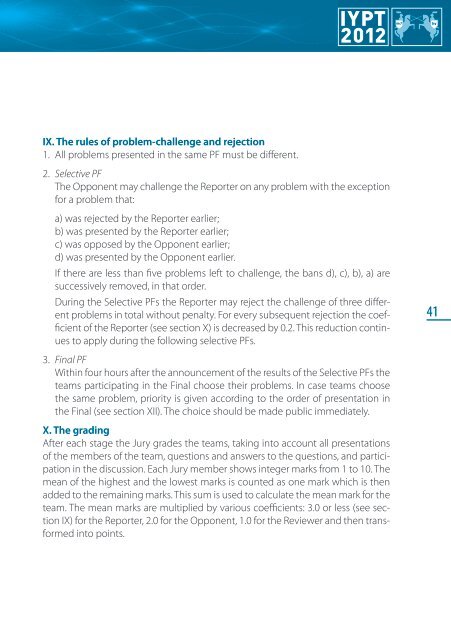The Physics World Cup The Physics World Cup - 25. IYPT Bad ...
The Physics World Cup The Physics World Cup - 25. IYPT Bad ...
The Physics World Cup The Physics World Cup - 25. IYPT Bad ...
You also want an ePaper? Increase the reach of your titles
YUMPU automatically turns print PDFs into web optimized ePapers that Google loves.
IX. <strong>The</strong> rules of problem-challenge and rejection<br />
1 . All problems presented in the same PF must be different .<br />
2 . Selective PF<br />
<strong>The</strong> Opponent may challenge the Reporter on any problem with the exception<br />
for a problem that:<br />
a) was rejected by the Reporter earlier;<br />
b) was presented by the Reporter earlier;<br />
c) was opposed by the Opponent earlier;<br />
d) was presented by the Opponent earlier .<br />
If there are less than five problems left to challenge, the bans d), c), b), a) are<br />
successively removed, in that order .<br />
During the Selective PFs the Reporter may reject the challenge of three different<br />
problems in total without penalty . For every subsequent rejection the coefficient<br />
of the Reporter (see section X) is decreased by 0 .2 . This reduction continues<br />
to apply during the following selective PFs .<br />
3 . Final PF<br />
Within four hours after the announcement of the results of the Selective PFs the<br />
teams participating in the Final choose their problems . In case teams choose<br />
the same problem, priority is given according to the order of presentation in<br />
the Final (see section XII) . <strong>The</strong> choice should be made public immediately .<br />
X. <strong>The</strong> grading<br />
After each stage the Jury grades the teams, taking into account all presentations<br />
of the members of the team, questions and answers to the questions, and participation<br />
in the discussion . Each Jury member shows integer marks from 1 to 10 . <strong>The</strong><br />
mean of the highest and the lowest marks is counted as one mark which is then<br />
added to the remaining marks . This sum is used to calculate the mean mark for the<br />
team . <strong>The</strong> mean marks are multiplied by various coefficients: 3 .0 or less (see section<br />
IX) for the Reporter, 2 .0 for the Opponent, 1 .0 for the Reviewer and then transformed<br />
into points .<br />
41


